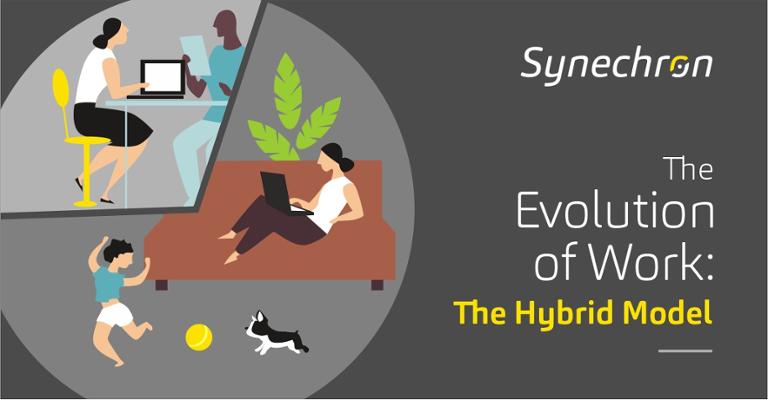There’s no debate. The pandemic has caused a reimagination of the global workforce. This has required business leaders across the world to reconsider their workplace and remote working environment from a new lens and totally different perspective and, in some cases, on a region-by-region basis. Not only has the environment been shifting, but importantly employee engagement as well as employee experience has morphed. Consequently, both the in-person and virtual working environments have seen significant changes. Selecting the optimal arrangement that works for everyone involved is part art and part science.
What is hybrid work?
Hybrid work requires reinterpreting the day-to-day workplace and work processes to meet the needs of a business as well as its employees. Hybrid work typically means there is a healthy, common sense and well-considered mix of employees working in office/on-site as well as working remotely. Whether that translates to a company asking employees to come into the office two or three days a week and work the rest remotely or working out an alternate, but logical and predictable other mix, is up to each business to determine. Whatever is judged to be the best hybrid arrangement should continue to enable a fruitful collaboration between colleagues, teams, departments, worksites and external contributors or business partners. Some experimentation is required. Research has shown that, for many of us, the ideal workweek includes employees working one or two days from a home office/location.
What are the benefits of a hybrid working arrangement?
At the company level, the greatest benefit is that you are directly investing in your colleagues’ well-being and safety, while indirectly improving the focus, level of productivity and efficiency across your workforce. Here are other points to consider:
- Rethink collaboration -- Collaboration does not necessarily have to be employees working within the same working space. Given the appropriate technology available today, collaboration can easily take place among employees working both on-site and off-site.
- Differences exist -- Remember, the precise way in which employees interact may take some getting used to. Spur of the moment, impromptu conversations, such as those that used to take place at the watercooler, coffee station or refrigerator, and quick person-to-person corridor/elevator chats are difficult.
- Self-paced work -- The trade-off is that remote working enables employees to ditch the commute and potentially invest that time doing productive work, at their own pace and as their schedule dictates.
- Flexibility rules -- Increased flexibility allows employees to ‘own their own time’ and better balance office tasks and family life/obligations. Such flexibility can add to employee satisfaction.
- Work-life balance -- Hybrid arrangements can also help employees better navigate life and work demands, and enable them to best prioritize and alternate between formal and informal office moments and quiet days of increased focus working from home.
- Real-life lessons -- Navigating new ways of working can be valuable life lessons that teach resiliency amid difficult times.
What are the challenges of a hybrid working arrangement?
Despite the best, carefully constructed plans for hybrid working, difficulties can present. Here’s what to consider:
- Technology deployed -- One of the greatest challenges lies in ensuring your business has the proper technology to allow employees to work from anywhere, with the security necessary to ensure that information, passwords, and sensitive business data is not compromised.
- Proper use of technology -- A related challenge is ensuring that each employee understands and can competently use the technology provided.
- Trial and error -- It can take employees some time to get used to the new hybrid on-site/off-site working customs and routines. The pandemic has taught employees to best judge which collaboration, presentation and meeting tools are the most appropriate across different scenarios and needs. Again, some experimentation may be required to determine which specific situations are best suited for the array of allowed technologies and the needs of different co-workers.
- Individualizing schedules -- Another challenge can be for each employee to map out their unique work-life balance plan, that includes working hours and non-working hours, and taking necessary breaks. Lacking some form of work-life boundaries being established, employees can face burnout, and difficulty separating their private and professional lives.
- Social isolation -- A feeling of isolation due to fewer direct social contacts can also be problematic. At Synechron, we make it a point to engage with all employees regularly, even if we don’t physically see them every day.
- Building relationships -- Onboarding new employees virtually during the pandemic reveals the ever-present challenge of building relationships with new colleagues and imparting the company’s strong organizational culture and values to them.
Hybrid working and Synechron
So how does Synechron approach the hybrid working landscape? The true answer is that after careful evaluation, we’ve embraced our vision of the hybrid working arrangement since September 2021, after compelling most of our global employees to work remotely to protect their health early in the pandemic -- from March 2020. But we know our leadership must constantly reevaluate the global pandemic, monitor emerging variants, check in with experts across our global locations and gauge how things are going with our dedicated employees’ well-being – both physical and mental health.
The pandemic has reinforced our need to be an agile company, and stand ready to make rapid workplace/workforce changes including regional accommodations, as necessary. While we would like to establish a ‘standard’ work arrangement across all global talent teams, we know this is not possible right now. However, we have learned from company outreach initiatives that the number one question we are asked by job candidates looking to work at Synechron is, “Do you offer a hybrid work arrangement?” Seems our hybrid recipe, which may need to be tweaked from time to time, will likely be here to stay.
Written By: John Gaunt, Chief Human Resources Officer, Synechron
Learn More About Synechron on Our Website
Search for Hybrid roles on our Career Site
